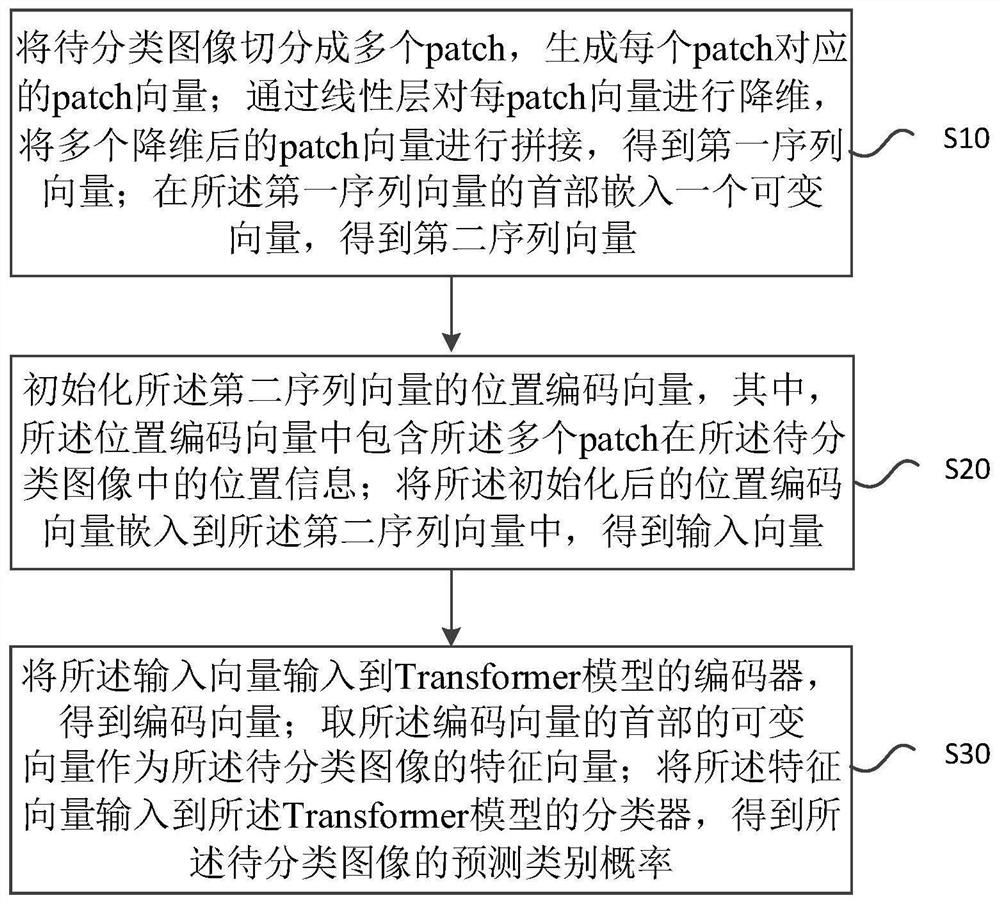Image classification method, training method of image classification model and equipment
A classification method and classification model technology, applied in neural learning methods, biological neural network models, character and pattern recognition, etc., can solve the problems of complex data, high cost of sample data labeling, and few data set labels, so as to improve the classification effect , good learning effect, pay attention to the effect of continuity
- Summary
- Abstract
- Description
- Claims
- Application Information
AI Technical Summary
Problems solved by technology
Method used
Image
Examples
Embodiment 1
[0059] This embodiment proposes an image classification method. figure 1 It is a flowchart of an image classification method provided by an embodiment of the present invention. Such as figure 1 As shown, the method includes S10-S30.
[0060] S10: Divide the image to be classified into multiple patches, and generate a patch vector corresponding to each patch; perform dimensionality reduction on each patch vector through a linear layer, and splice multiple dimensionality-reduced patch vectors to obtain a first sequence of vectors; A variable vector is embedded in the head of the first sequence vector to obtain a second sequence vector, wherein the variable vector has the same size as each dimension-reduced patch vector, and the variable vector corresponds to the multiple The patch that can best represent the features of the image to be classified among the patches.
[0061] Optionally, the image to be classified is divided into multiple patches and flattened into a sequence, ...
Embodiment 2
[0088] This embodiment provides a method for training an image classification model, which is used to train the image classification model formed by the image classification method described in Embodiment 1. figure 2 It is a flowchart of a method for training an image classification model provided by an embodiment of the present invention. Such as figure 2 As shown, the method includes steps S01-S06.
[0089] S01: Obtain a training data set D, wherein the training data set includes a labeled data set D l and unlabeled dataset D u , each training data is a training image, each labeled data d l label is d l the true class of y l .
[0090] S02: For each labeled data d l Perform a random data enhancement to obtain an enhanced labeled dataset For each unlabeled data d u Perform K random data enhancements to obtain K enhanced unlabeled datasets k=1,...,K, all d u of K The union of is recorded as Each unlabeled data d u of K Respectively input the image classif...
Embodiment 3
[0126] Figure 4 It is a flow chart of another image classification method provided by the embodiment of the present invention. The method is based on Transformer's semi-supervised algorithm to realize the network learning process of image classification, including training phase and prediction phase. Such as Figure 4 As shown, the method includes S1-S8.
[0127] S1: Predict pseudo-labels. Firstly, random data enhancement is performed on all unlabeled data, repeated K times, then the enhanced unlabeled data is input into the model for prediction, and K pseudo-labels are obtained, and finally the average operation is performed as the pseudo-label of unlabeled data.
[0128] S2: image block processing. The input image is divided into multiple patches and flattened into a sequence, and then the dimensionality reduction operation is performed through a learnable linear projection. Finally, a vector of the same size as the patch (referred to as "patch embedding vector") is em...
PUM
 Login to View More
Login to View More Abstract
Description
Claims
Application Information
 Login to View More
Login to View More - R&D
- Intellectual Property
- Life Sciences
- Materials
- Tech Scout
- Unparalleled Data Quality
- Higher Quality Content
- 60% Fewer Hallucinations
Browse by: Latest US Patents, China's latest patents, Technical Efficacy Thesaurus, Application Domain, Technology Topic, Popular Technical Reports.
© 2025 PatSnap. All rights reserved.Legal|Privacy policy|Modern Slavery Act Transparency Statement|Sitemap|About US| Contact US: help@patsnap.com



